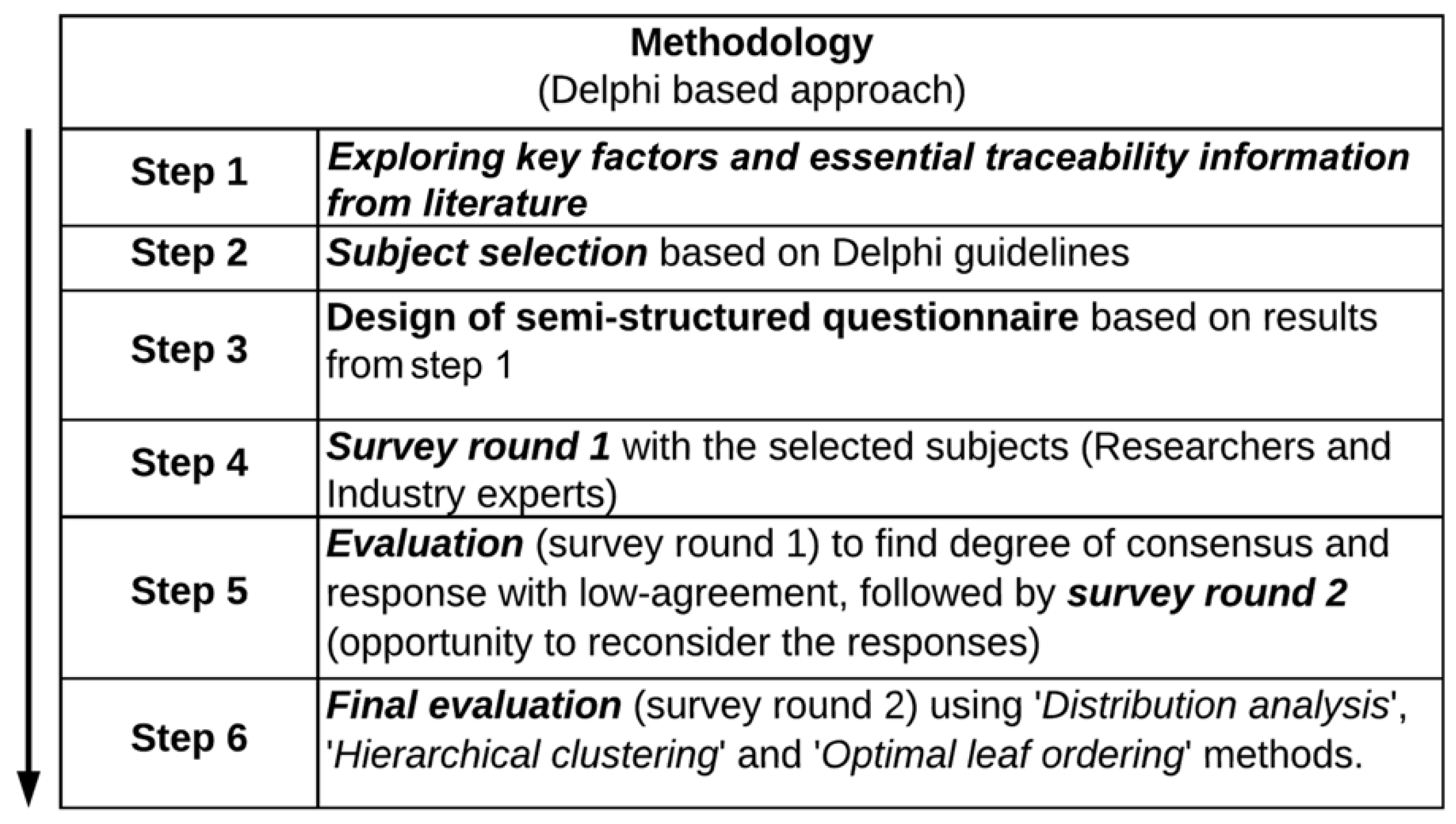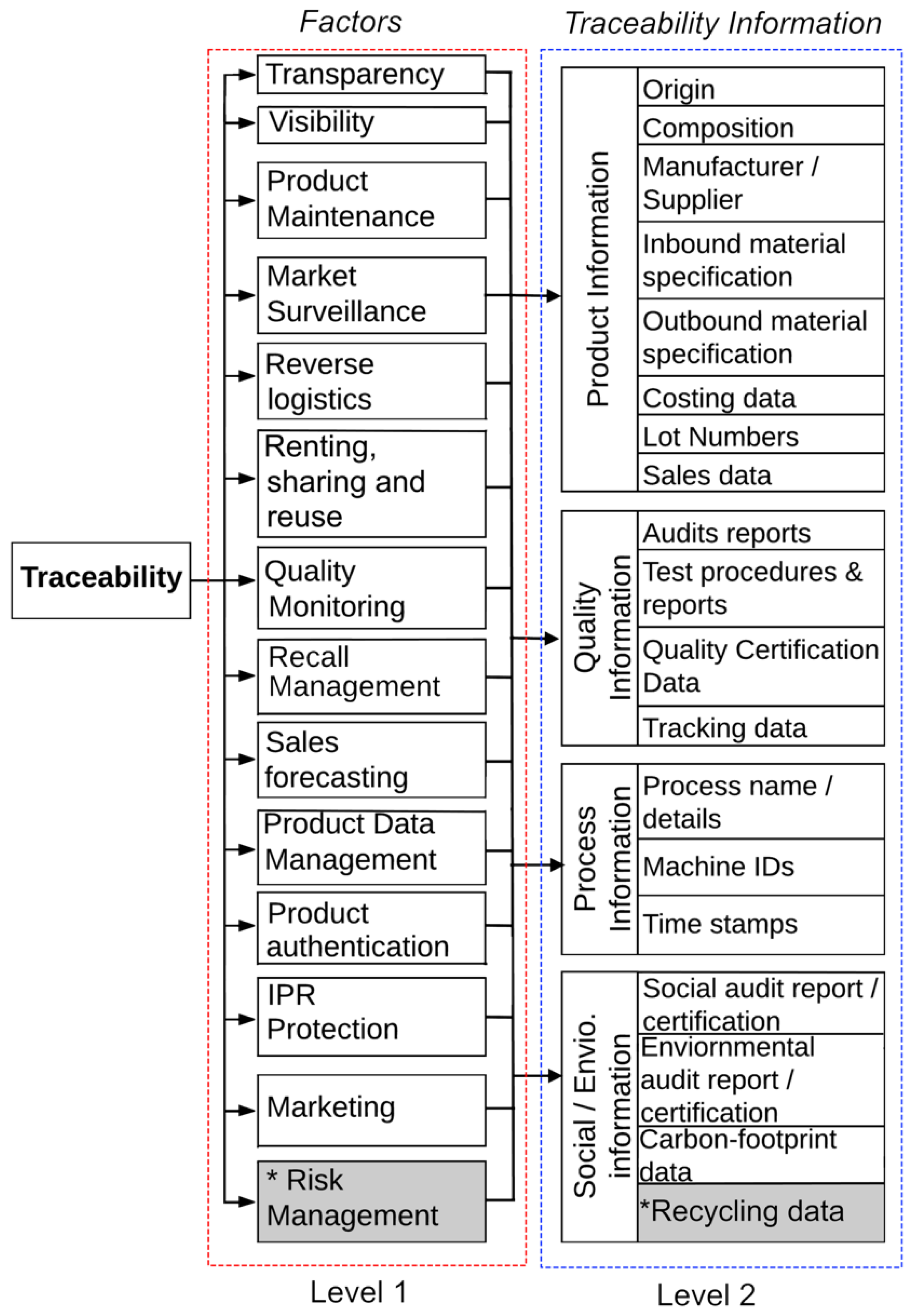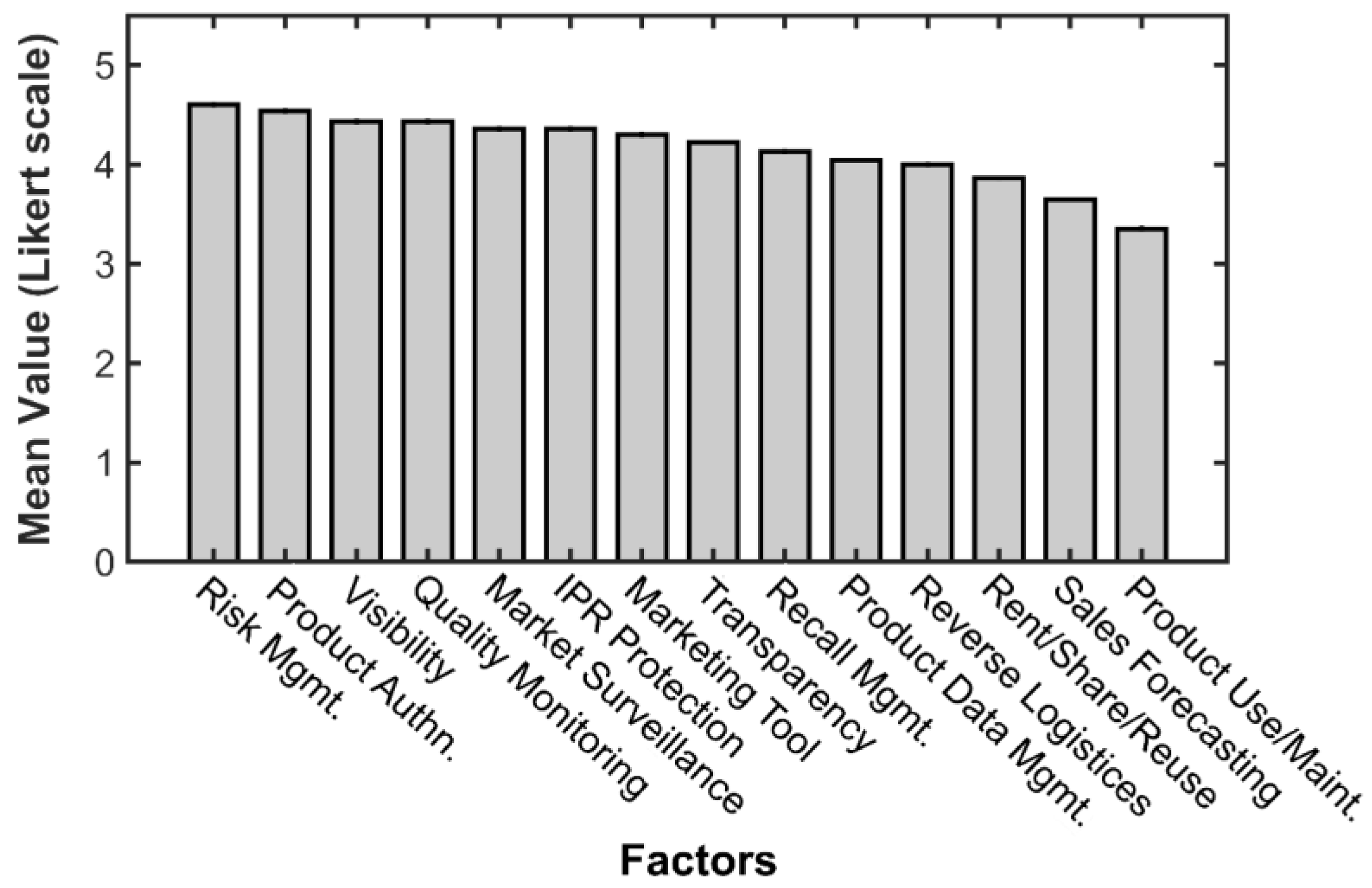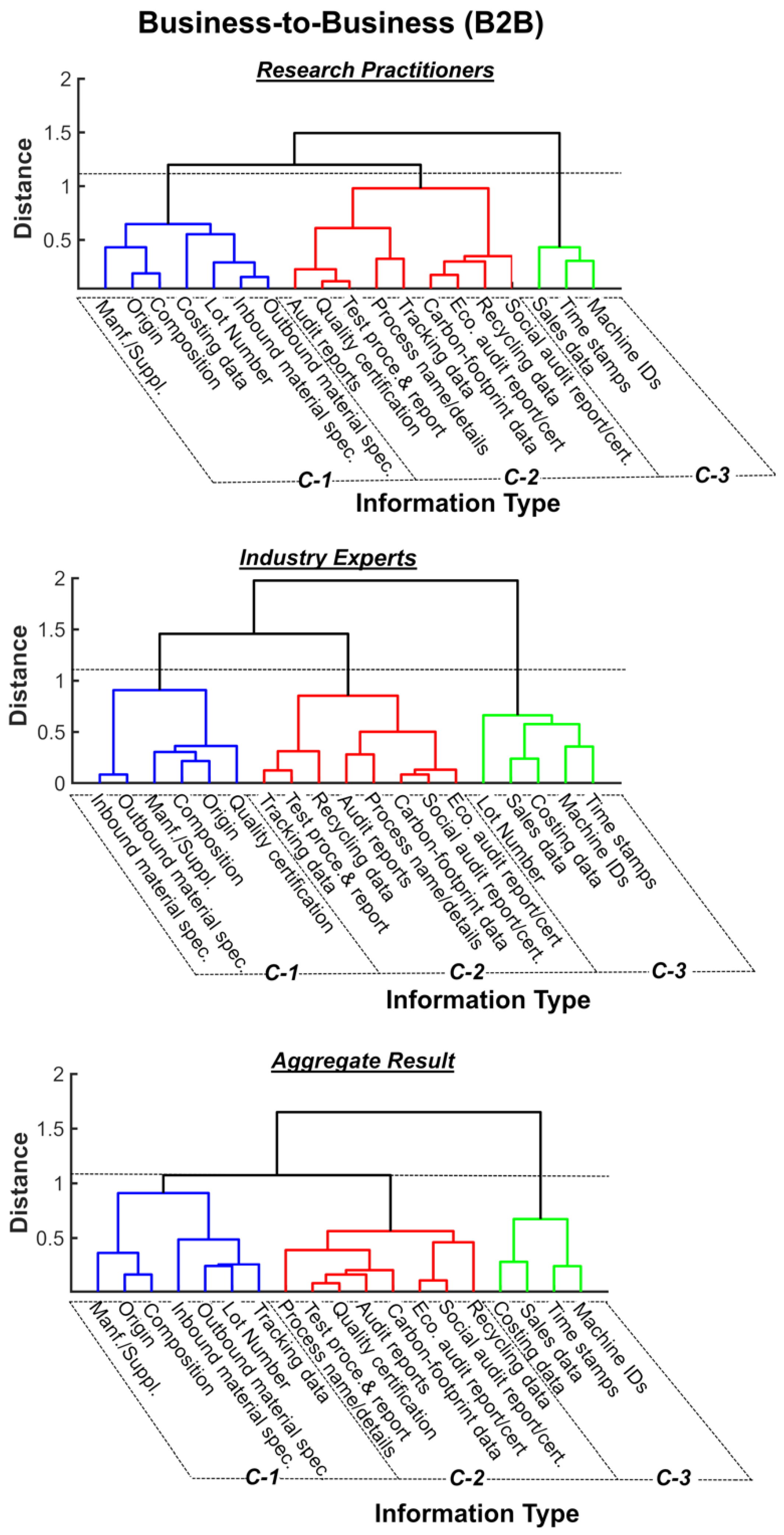Traceability in Textile and Clothing Supply Chains: Classifying Implementation Factors and Information Sets via Delphi Study
Abstract
1. Introduction
2. Methodology
2.1. Exploring Key Factors and Essential Traceability Information from the Literature (Step 1)
2.1.1. Traceability—Factors
2.1.2. Traceability—Information Sets
2.2. Subject Selection (Step 2)
2.3. Design of the Semi-Structured Questionnaire (Step 3)
2.4. Survey Round 1 (Step 4)
2.5. Evaluation (Round 1) and Survey Round 2 (Step 5)
2.6. Final Evaluation (Step 6)
3. Results
3.1. Traceability Implementation Factors in Textile and Clothing (TC) Supply Chains
3.2. Traceability Information in TC Supply Chains
4. Analytical Discussion
4.1. Traceability Implementation Factors
4.2. Traceability Information in TC Supply Chains
5. Conclusions
5.1. Research Implications
5.2. Limitations and Future Research
Author Contributions
Funding
Conflicts of Interest
References
- Boström, M.; Micheletti, M. Introducing the Sustainability Challenge of Textiles and Clothing. J. Consum. Policy 2016, 39, 367–375. [Google Scholar] [CrossRef]
- Egels-Zandén, N.; Hulthén, K.; Wulff, G. Trade-offs in supply chain transparency: The case of Nudie Jeans Co. J. Clean. Prod. 2015, 107, 95–104. [Google Scholar] [CrossRef]
- Kumar, V.; Agrawal, T.K.; Wang, L.; Chen, Y. Contribution of traceability towards attaining sustainability in the textile sector. Text. Cloth. Sustain. 2017, 3, 5. [Google Scholar] [CrossRef]
- Grimm, J.H.; Hofstetter, J.S.; Sarkis, J. Exploring sub-suppliers’ compliance with corporate sustainability standards. J. Clean. Prod. 2016, 112, 1971–1984. [Google Scholar] [CrossRef]
- Freise, M.; Seuring, S. Social and environmental risk management in supply chains: A survey in the clothing industry. Logist. Res. 2015, 8, 2. [Google Scholar] [CrossRef]
- Richero, R.; Ferrigno, S. A Background Analysis on Transparency and Traceability in the Garment Value Chain; Directorate General for International Cooperation and Development, European Commission: Brussels, Belgium, 2016. [Google Scholar]
- Corbellini, S.; Ferraris, F.; Parvis, M. A Cryptographic System for Brand Authentication and Material Traceability in the Textile Industry. In Proceedings of the 2006 IEEE Instrumentation and Measurement Technology Conference, Sorrento, Italy, 24–27 April 2006; pp. 1331–1335. [Google Scholar]
- Wajsman, N.; Arias Burgos, C.; Davies, C. The Economic Cost of IPR Infringement in The Clothing, Footwear and Accessories Sector; European Union Intellectual Property Office: Alicante, Spain, 2015. [Google Scholar]
- OECD. OECD Due Diligence Guidance for Responsible Business Conduct Responsible Supply Chains in the Garment and Footwear Sector; OECD: Paris, France, 2017. [Google Scholar]
- Olsen, P.; Borit, M. The components of a food traceability system. Trends Food Sci. Technol. 2018, 77, 143–149. [Google Scholar] [CrossRef]
- Thakur, M.; Donnelly, K.A.-M. Modeling traceability information in soybean value chains. J. Food Eng. 2010, 99, 98–105. [Google Scholar] [CrossRef]
- Chaudhuri, A.; Dukovska-Popovska, I.; Subramanian, N.; Chan, H.K.; Bai, R. Decision-making in cold chain logistics using data analytics: A literature review. Int. J. Logist. Manag. 2018, 29, 839–861. [Google Scholar] [CrossRef]
- Doukidis, G.; Pramatari, K.; Kelepouris, T. RFID-enabled traceability in the food supply chain. Ind. Manag. Data Syst. 2007, 107, 183–200. [Google Scholar]
- Li, Z.; Liu, G.; Liu, L.; Lai, X.; Xu, G. IoT-based tracking and tracing platform for prepackaged food supply chain. Ind. Manag. Data Syst. 2017, 117, 1906–1916. [Google Scholar] [CrossRef]
- Paltriccia, C.; Tiacci, L. Supplying networks in the healthcare sector: A new outsourcing model for materials management. Ind. Manag. Data Syst. 2016, 116, 1493–1519. [Google Scholar] [CrossRef]
- Kumar, V.; Hallqvist, C.; Ekwall, D. Developing a Framework for Traceability Implementation in the Textile Supply Chain. Systems 2017, 5, 33. [Google Scholar] [CrossRef]
- Ritch, E.L. Consumers interpreting sustainability: Moving beyond food to fashion. Int. J. Retail Distrib. Manag. 2015, 43, 1162–1181. [Google Scholar] [CrossRef]
- Hsu, C.-C.; Sandford, B.A. The Delphi Technique; Making Sense of Consensus. Pract. Assess. Res. Eval. 2007, 12, 1–8. [Google Scholar]
- Brinch, M.; Stentoft, J.; Jensen, J.K.; Rajkumar, C. Practitioners understanding of big data and its applications in supply chain management. Int. J. Logist. Manag. 2018, 29, 555–574. [Google Scholar] [CrossRef]
- Darkow, I.-L.; von der Gracht, H.A. Energy-constrained and low-carbon scenarios for the transportation and logistics industry. Int. J. Logist. Manag. 2016, 27, 142–166. [Google Scholar]
- Kembro, J.; Näslund, D.; Olhager, J. Information sharing across multiple supply chain tiers: A Delphi study on antecedents. Int. J. Prod. Econ. 2017, 193, 77–86. [Google Scholar] [CrossRef]
- Förster, B.; Keller, J.; von der Gracht, H.A.; Darkow, I.L. Delphi-based strategic issue management: Crafting consumer goods supply chain strategy. Int. J. Phys. Distrib. Logist. Manag. 2014, 44, 373–391. [Google Scholar]
- Nair, R.; Mason, R. Supply-side strategic flexibility capabilities in container liner shipping. Int. J. Logist. Manag. 2013, 24, 22–48. [Google Scholar]
- Okoli, C.; Pawlowski, S.D. The Delphi method as a research tool: An example, design considerations and applications. Inf. Manage. 2004, 42, 15–29. [Google Scholar] [CrossRef]
- Pal, R.; Harper, S.; Vellesalu, A. Competitive manufacturing for reshoring textile and clothing supply chains to high-cost environment: A Delphi study. Int. J. Logist. Manag. 2018, 29, 1147–1170. [Google Scholar] [CrossRef]
- Ringsberg, H. Perspectives on food traceability: A systematic literature review. Supply Chain Manag. Int. J. 2014, 19, 558–576. [Google Scholar] [CrossRef]
- Sarpong, S. Traceability and supply chain complexity: Confronting the issues and concerns. Eur. Bus. Rev. 2014, 26, 271–284. [Google Scholar] [CrossRef]
- Cheng, M.J.; Simmons, J.E.L. Traceability in Manufacturing Systems. Int. J. Oper. Prod. Manag. 1994, 14, 4–16. [Google Scholar] [CrossRef]
- Doorey, D.J. The Transparent Supply Chain: From Resistance to Implementation at Nike and Levi-Strauss. J. Bus. Ethics 2011, 103, 587–603. [Google Scholar] [CrossRef]
- Kumar, V. Exploring Fully Integrated Textile Tags and Information Systems for Implementing Traceability in Textile Supply Chains; University Lille 1 in Collaboration with Högskolan i Borås (Sweden) and Soochow University (Suzhou): Borås, Sweden, 2017. [Google Scholar]
- Strähle, J.; Merz, L. Case Study: Total Transparency at Honestby.com. In Green Fashion Retail; Strähle, J., Ed.; Springer Series in Fashion Business; Springer: Singapore, 2017; pp. 269–291. ISBN 978-981-10-2439-9. [Google Scholar]
- Canavari, M.; Centonze, R.; Hingley, M.; Spadoni, R. Traceability as part of competitive strategy in the fruit supply chain. Br. Food J. 2010, 112, 171–186. [Google Scholar] [CrossRef]
- Morgan, T.R.; Richey, R.G., Jr.; Ellinger, A.E. Supplier transparency: Scale development and validation. Int. J. Logist. Manag. 2018, 29, 959–984. [Google Scholar] [CrossRef]
- (Nel) Wognum, P.M.; Bremmers, H.; Trienekens, J.H.; van der Vorst, J.G.A.J.; Bloemhof, J.M. Systems for sustainability and transparency of food supply chains—Current status and challenges. Adv. Eng. Inform. 2011, 25, 65–76. [Google Scholar] [CrossRef]
- Shin, S. Consumers’ Use of Care-label Information in the Laundering of Apparel Products. J. Text. Inst. 2000, 91, 20–28. [Google Scholar] [CrossRef]
- Tao, F.; Wang, Y.; Zuo, Y.; Yang, H.; Zhang, M. Internet of Things in product life-cycle energy management. J. Ind. Inf. Integr. 2016, 1, 26–39. [Google Scholar] [CrossRef]
- Assmuth, T.; Häkkinen, P.; Heiskanen, J.; Kautto, P.; Lindh, P.; Mattila, T.; Mehtonen, J.; Saarinen, K. Risk Management and Governance of Chemicals in Articles. Case Study Textiles; Finnish Environment Institute: Helsinki, Finland, 2011; ISBN 978-952-11-3901-7. [Google Scholar]
- Machado, S.M.; Paiva, E.L.; da Silva, E.M. Counterfeiting: Addressing mitigation and resilience in supply chains. Int. J. Phys. Distrib. Logist. Manag. 2018, 48, 139–163. [Google Scholar] [CrossRef]
- Alemanno, A. Solving the Problem of Scale: The European Approach to Import Safety and Security Concerns; Social Science Research Network: Rochester, NY, USA, 2009. [Google Scholar]
- Alemanno, A. European Food Import Safety regime under a Stress Test: The Melamine Contamination of the Global Food Supply Chain. Erasmus Law Rev. 2010, 3, 203. [Google Scholar]
- Legnani, E.; Cavalieri, S.; Pinto, R.; Dotti, S. The Potential of RFID Technology in the Textile and Clothing Industry: Opportunities, Requirements and Challenges. In Unique Radio Innovation for the 21st Century; Ranasinghe, D.C., Sheng, Q.Z., Zeadally, S., Eds.; Springer: Berlin/Heidelberg, Germany, 2011; pp. 309–329. ISBN 978-3-642-03461-9. [Google Scholar]
- Pigni, F.; Crave, S.; Ravaini, A. Traceability in the textile and clothing industry: Issues and implications for RFId adoption. In Proceedings of the 2nd Mediterranean Conference on Information Systems, MCIS 2007, Venice, Italy, 4–8 October 2007. [Google Scholar]
- Bechini, A.; Cimino, M.G.C.A.; Marcelloni, F.; Tomasi, A. Patterns and technologies for enabling supply chain traceability through collaborative e-business. Inf. Softw. Technol. 2008, 50, 342–359. [Google Scholar] [CrossRef]
- Nativi, J.J.; Lee, S. Impact of RFID information-sharing strategies on a decentralized supply chain with reverse logistics operations. Int. J. Prod. Econ. 2012, 136, 366–377. [Google Scholar] [CrossRef]
- Wyld, D.C. Taking out the Trash (And the Recyclables): RFID and the Handling of Municipal Solid Waste. Int. J. Softw. Eng. Appl. 2010, 1, 1–13. [Google Scholar]
- Cheng, Z.; Xiao, J.; Xie, K.; Huang, X. Optimal Product Quality of Supply Chain Based on Information Traceability in Fashion and Textiles Industry: An Adverse Logistics Perspective. Math. Probl. Eng. 2013, 2013, e629363. [Google Scholar] [CrossRef]
- MacKenzie, C.A.; Apte, A. Modeling disruption in a fresh produce supply chain. Int. J. Logist. Manag. 2017, 28, 656–679. [Google Scholar] [CrossRef]
- Meuwissen, M.P.M.; Velthuis, A.G.J.; Hogeveen, H.; Huirne, R.B.M. Traceability and certification in meat supply chains. J. Agribus. 2003, 21, 167–181. [Google Scholar]
- Kwok, S.K.; Wu, K.W. RFID-based intra-supply chain in textile industry. Ind. Manag. Data Syst. 2009, 109, 1166–1178. [Google Scholar] [CrossRef]
- Jansen-Vullers, M.H.; van Dorp, C.A.; Beulens, A.J.M. Managing traceability information in manufacture. Int. J. Inf. Manag. 2003, 23, 395–413. [Google Scholar] [CrossRef]
- Sun, C.-H.; Li, W.-Y.; Zhou, C.; Li, M.; Ji, Z.-T.; Yang, X.-T. Anti-counterfeit code for aquatic product identification for traceability and supervision in China. Food Control 2014, 37, 126–134. [Google Scholar] [CrossRef]
- Guercini, S.; Runfola, A. The integration between marketing and purchasing in the traceability process. Ind. Mark. Manag. 2009, 38, 883–891. [Google Scholar] [CrossRef]
- Roosen, J. Marketing of Safe Food Through Labeling. J. Food Distrib. Res. 2003, 34, 77. [Google Scholar]
- Rijswijk, W.V.; Frewer, L.J. Consumer needs and requirements for food and ingredient traceability information. Int. J. Consum. Stud. 2012, 36, 282–290. [Google Scholar] [CrossRef]
- Lumsden, K.; Mirzabeiki, V. Determining the value of information for different partners in the supply chain. Int. J. Phys. Distrib. Logist. Manag. 2008, 38, 659–673. [Google Scholar] [CrossRef]
- Phau, I.; Teah, M.; Chuah, J. Consumer attitudes towards luxury fashion apparel made in sweatshops. J. Fash. Mark. Manag. Int. J. 2015, 19, 169–187. [Google Scholar] [CrossRef]
- Radhakrishnan, S. The Sustainable Apparel Coalition and the Higg Index. In Roadmap to Sustainable Textiles and Clothing; Textile Science and Clothing Technology; Springer: Singapore, 2015; pp. 23–57. ISBN 978-981-287-163-3. [Google Scholar]
- Bar-Joseph, Z.; Gifford, D.K.; Jaakkola, T.S. Fast optimal leaf ordering for hierarchical clustering. Bioinformatics 2001, 17, S22–S29. [Google Scholar] [CrossRef]
- Chaudhuri, A.; Srivastava, S.K.; Srivastava, R.K. Propagation of risks and their impact on performance in fresh food retail. Int. J. Logist. Manag. 2015, 26, 568–602. [Google Scholar]
- Giannakis, M.; Papadopoulos, T. Supply chain sustainability: A risk management approach. Int. J. Prod. Econ. 2016, 171, 455–470. [Google Scholar] [CrossRef]
- McMillen, D.; Alvarez, M.; Craig, S. Security Trends in the Manufacturing Industry [White Paper]; IBM: New York, NY, USA, 2016; pp. 1–19. [Google Scholar]
- Algayerova, O. TEXTILE4SDG12: Transparency in Textile Value Chains in Relation to the Environmental, Social and Human Health Impacts of Parts, Components and Production Processes; United Nations Economic Commission for Europe: Geneva, Switzerland, 2017; pp. 1–27. [Google Scholar]
- Bradu, C.; Orquin, J.L.; Thøgersen, J. The Mediated Influence of a Traceability Label on Consumer’s Willingness to Buy the Labelled Product. J. Bus. Ethics 2014, 124, 283–295. [Google Scholar] [CrossRef]
- Goswami, S. Traceability to Farm and Factory, Country of Manufacturing, and Apparel Purchase Scenario. University of Missouri–Columbia, 2014. Available online: https://mospace.umsystem.edu/xmlui/bitstream/handle/10355/44421/Research.pdf?sequence=1 (accessed on 20 February 2019).
- Agrawal, T.K.; Sharma, A.; Kumar, V. Blockchain-Based Secured Traceability System for Textile and Clothing Supply Chain. In Artificial Intelligence for Fashion Industry in the Big Data Era; Thomassey, S., Zeng, X., Eds.; Springer Series in Fashion Business; Springer: Singapore, 2018; pp. 197–208. ISBN 9789811300790. [Google Scholar]





| Influencing Factors | Supporting Authors | How It Influences | |
|---|---|---|---|
| Textile | Others | ||
| Transparency | [2,29,30,31] | [32,33,34] | Transparency is the extent to which information is shared among the supply chain partners, and visibility implies the extent to which a buyer can trace back the details about the suppliers and sub-suppliers. Both are high in demand and crucial elements for a sustainable TC supply chain. To achieve these, an effective traceability mechanism is required that can connect and integrate all the involved supply chain partners. |
| Visibility | |||
| Product Maintenance | [30,35] | [36] | Textile product maintenance in its use-phase, especially during washing and drying, is one of the key concerns influencing the durability and recyclability of the textile product. Traceability mechanisms are essential to share product maintenance aspects with end users, and at the same time an active traceability mechanism can be programmed to record product use-phase data (e.g., number of washes) that is crucial in recycling stages |
| Market surveillance | [30,37] | [38,39,40] | Market surveillance by public authorities that closely observes products in the market and ensures that the products conform to the applicable law, require crucial information about the history, origin, and composition of product/raw material and intermediate product. Examples of such authorities are the Administrative Cooperation Group (AdCos), Rapid Alert System (RAPEX), etc. Traceability mechanisms connect the supply chain partners and enables tracking and tracing of product at each stage of the supply chain. |
| Reverse logistics | [41,42] | [26,43,44,45] | Reverse logistics management, involves collection, sorting and segregating of the used product during recycling and inventory management during re-manufacturing and return. An automated reverse logistic system using traceability mechanisms and information can save cost, time, and enable effective recycling, reuse, and renting of products. |
| Renting, sharing and reuse | |||
| Quality Monitoring | [16,42,46] | [47,48] | Recording and sharing quality-related information enables effect control, monitoring of product quality, and recall management to identify the origin of defects. In the case of recalls, traceability mechanisms can trace the origin of the defect and locate the responsible partner. |
| Recall Mechanism | |||
| Sales forecasting | [41,49] | [26,43,50] | Real-time tracking and tracing of product and product data management enables effective and more precise sales forecasts, production planning, and control. This can be ensured by a traceability mechanism that integrates the supply chain and records real-time product data. |
| Production data management | |||
| Product authentication | [7,30] | [38,43,51] | Product and information security are one of the key concerns of the TC supply chain that requires secure technologies and systems for counterfeit detection and data protection. In this direction, a traceability system with secured mechanisms can ensure product authentication and prevent data leakages. |
| Intellectual Property Rights (IPR) Protection | |||
| Marketing | [30,52] | [43,53] | In this era of fast fashion consumers, more information is needed about the product to make an ethical buying decision. Enabling the customer to trace the history of textile products through a traceability mechanism can create a positive brand image and boost sales. |
| Information Sets | Supporting Authors | Sub-Category | Description |
|---|---|---|---|
| Product Information | [11,16,31,49,50,55] | Origin | Origin of the final product, component, sub-component, and raw materials utilized in the production of the final product. |
| Composition | Composition of the final product, component, sub-component, and raw materials utilized in the production of the final product. | ||
| Manufacturer/ supplier details | Information about all the manufacturers, suppliers and sub-suppliers involved throughout the lifecycle of the product. | ||
| Inbound material specifications | A detailed description of design and product/material specifications that are procured from the supplier/upstream actor. | ||
| Outbound product specifications | A detailed description of design and product/material specifications of finished product that is transferred to the next downstream actor | ||
| Costing data | Information related to the cost of the final product, raw material, and the entire intermediate product. | ||
| Lot numbers | Unique series of the number provided to a bundle or lot of product to facilitate batch traceability | ||
| Sales data | Real-time data related to product sales in different retail channels. | ||
| Quality Information | [11,16,31] | Audit reports | Various audit-quality audit reports done throughout the lifecycle of the product |
| Test procedures and reports | Various audit-quality test procedures and test reports done throughout the lifecycle of the product | ||
| Quality Certification Data | Various quality certifications related to raw material, intermediate product, and final product throughout the lifecycle of the product | ||
| Tracking data of surplus or damaged material/product | Tracking data of each product, the damaged or discarded product/intermediate, and raw material in the supply chain. | ||
| Process Information | [11,16,31] | Process names/details | Information and details about all the involved manufacturing processes throughout the lifecycle of the product. |
| Machines Ids | Machine Ids of the machines involved in product processing throughout its lifecycle. | ||
| Timestamps | Time stamps of all the important events and processes throughout the lifecycle of a product. | ||
| Social-Environmental Information | [16,17,31,56] | Social audit-report/certification | Various social audit reports and certifications associated directly or indirectly with the product |
| Environmental audit-report/certification | Various environmental audit reports and certifications associated directly or indirectly with the product | ||
| Carbon footprint data of products | Complete carbon footprint data of the final product throughout its lifecycle |
| Implementation Factors | Mean (SD) - | ||||||
|---|---|---|---|---|---|---|---|
| Round 1 (R1) | Round 2 (R2) | ||||||
| Rec (N = 12) | Ind. (N = 11) | Aggregate | Rec (N = 12) | Ind. (N = 11) | Aggregate | ||
| 1 | Transparency | 4.17(0.69) | 4.27(0.61) | 4.22(0.66) | - | - | - |
| 2 | Visibility | 4.33(0.47) | 4.54(0.50) | 4.43(0.49) | - | - | - |
| 3 | Quality Monitoring and control | 4.58(0.64) | 4.27(0.45) | 4.43(0.58) | - | - | - |
| 4 | Recall mechanism | 4.42(0.76) | 3.82(0.57) | 4.13(0.74) | - | - | - |
| 5 | Marketing Tool | 4.16(0.69) | 4.45(0.66) | 4.30(0.68) | - | - | - |
| 6 | Market Surveillance | 4.58(0.49) | 4.10(0.70) | 4.36(0.64) | - | - | - |
| 7 | Product authentication | 4.58(0.64) | 4.50(0.67) | 4.54(0.65) | - | - | - |
| 8 | IPR protection | 4.33(0.74) | 4.40(0.66) | 4.36(0.71) | - | - | - |
| 9 | Product Data Management | 4.33(0.74) | 3.70(0.85) | 4.04(0.79) | - | - | - |
| 10 | Sales Forecasting | 3.92(0.95) | 3.50(0.81) | 3.72(0.91) | 3.75(0.60) | 3,55(0.78) | 3.65(0.70) |
| 11 | Product use/maintenance | 3.66(1.10) | 3.30(1.00) | 3.50(1.08) | 3.41(0.75) | 3.27(0.75) | 3.35(0.75) |
| 12 | Reverse logistics activities | 4.25(0.82) | 3.70(1.01) | 4.00(0.95) | 4.08(0.85) | 3.90(0.67) | 4.00(0.77) |
| 13 | Renting, sharing and reuse | 3.67(0.62) | 4.10(0.85) | 3.86(0.76) | - | - | - |
| 14 | * Risk Management | - | - | - | 4.75(0.43) | 4.45(0.65) | 4.60(0.57) |
© 2019 by the authors. Licensee MDPI, Basel, Switzerland. This article is an open access article distributed under the terms and conditions of the Creative Commons Attribution (CC BY) license (http://creativecommons.org/licenses/by/4.0/).
Share and Cite
Agrawal, T.K.; Pal, R. Traceability in Textile and Clothing Supply Chains: Classifying Implementation Factors and Information Sets via Delphi Study. Sustainability 2019, 11, 1698. https://doi.org/10.3390/su11061698
Agrawal TK, Pal R. Traceability in Textile and Clothing Supply Chains: Classifying Implementation Factors and Information Sets via Delphi Study. Sustainability. 2019; 11(6):1698. https://doi.org/10.3390/su11061698
Chicago/Turabian StyleAgrawal, Tarun Kumar, and Rudrajeet Pal. 2019. "Traceability in Textile and Clothing Supply Chains: Classifying Implementation Factors and Information Sets via Delphi Study" Sustainability 11, no. 6: 1698. https://doi.org/10.3390/su11061698
APA StyleAgrawal, T. K., & Pal, R. (2019). Traceability in Textile and Clothing Supply Chains: Classifying Implementation Factors and Information Sets via Delphi Study. Sustainability, 11(6), 1698. https://doi.org/10.3390/su11061698





